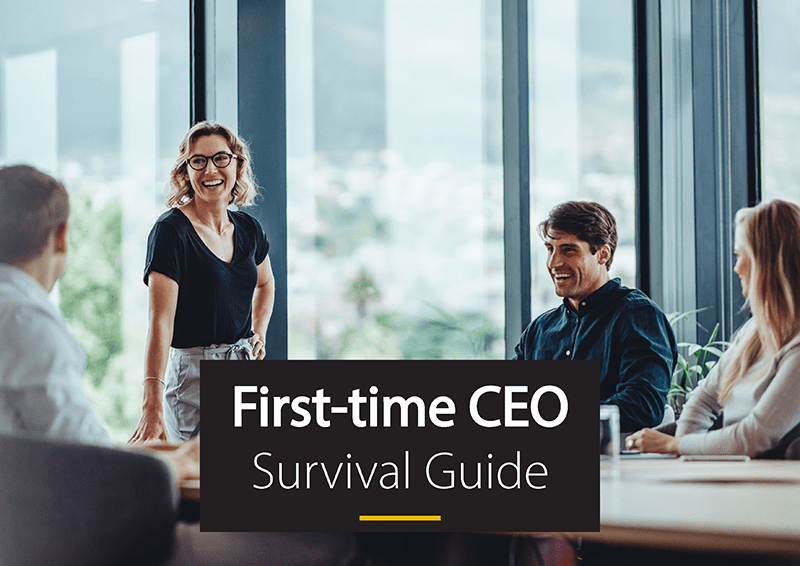You are here: Home / Insights / Leadership / What every CEO needs to do in their first 100 days

What every CEO needs to do in their first 100 days

As a new CEO, you never get a second chance to make a first impression. Those first 100 days in the job are crucial, as they set the tone for your tenure and potentially impact your effectiveness as a leader.
But what should you do to make a strong start? For insight and advice, we turned to three seasoned executives from our global Vistage community: Carol Steinberg, President of CIK Consulting; Robert Powell, CEO of Invictus Leadership Group; and Charles Bernard, CEO of Criteria for Success. Together, they offered these 15 tips for CEOs in their first 100 days.
15 steps to take in your first 100 days as CEO
- Take time beforehand for deep thinking and in-depth research
- Start off rested
- Understand what you’re walking into
- Lay out your game plan
- Prioritise knowledge transfer
- Communicate your intentions
- Listen
- Dig into talent issues
- Build a cross-disciplinary sales team
- Get to know your people
- Find creative ways to connect
- Resolve conflicts right away
- Approach customers with 3 questions
- Create a sales playbook
- Invite employees to ask you anything
Read more about each step below.
1. Take time beforehand for deep thinking and in-depth research.
Before your official start date as a new CEO, spend time conducting in-depth research about your competitive environment, says Steinberg. Consider some of the following:
- Look closely at what your competitors are doing and how they’ve been successful.
- Study the economic trends that could impact your business in the near term.
- Start thinking ahead, considering how you might use advancements such as Artificial Intelligence or the Internet of Things for competitive gains in the future.
2. Start the job rested.
Starting a new role and becoming a new leader are stressful positions. To deal with the demands of leading a company, you have to come to the job feeling rested. So, take a long vacation before you start. “Really get away — for at least a week — so that you won’t get exhausted in the new role,” says Powell. “I’ve seen it before: Someone immediately jumped from one job into another, and they never had time to take a break. They were ineffective.”
3. Understand what you’re walking into.
Is the business you’re leading financially stable or in financial distress? If it’s the latter, have a good understanding of the issues before going in, along with a realistic plan for how you’re going to handle them. “If the house is burning, you’ll need to make quick decisions around what changes need to take place and what expenses have to be cut,” says Powell. For example, you might need to realign product mixes, or realign the entire organisation, in your first 100 days.
4. Lay out your game plan.
As a CEO, you’re the person responsible for setting a vision and getting everyone else on board. Establishing this vision in your first 100 days will help you stay focused on the issues that matter most, says Steinberg. “It’s really important to lay out your game plan so you don’t get distracted, fall down rabbit holes, chase after tangents or ignore the things that you should really be looking at,” she explains. It will also help you manage the wide array of challenges you’ll inherit as a new CEO, whether you’re replacing someone who retired or someone who was let go.
What should be included in a 100 day plan?
Now that you’re in charge you’ll need a plan that can be communicated with senior leaders and employees at all levels. As you draft your plan, consider including:
- Your company’s strengths and opportunities, as well as the current state of the marketplace
- Your main speaking points for each stakeholder
- Your action and communication plans
- Your goals
- Your metrics for measuring success
What should a CEO do on the first day?
First impressions matter. On your first day as a new CEO:
- Contact board members
- Interact with as many staff–across levels and departments– as you can
- Set aside time to introduce yourself to key stakeholders
- Ask questions
- Demonstrate interest in understanding roles and challenges
5. Prioritise knowledge transfer.
As a CEO, you need to give people the context, permission and space to transfer knowledge to other people in the company, says Bernard. Otherwise, you’ll inevitably become a bottleneck for your direct reports. In leadership team meetings, he says, encourage your top salespeople to share their “secret sauce” with their colleagues. Better yet, create projects that organically involve knowledge transfers, such as building a sales playbook for the company.
6. Communicate your intentions so people don’t speculate.
Within your first month on the job, have a full company meeting and outline your action plan. Communicate what you intend to do over the next one to two quarters. Be open and transparent with your plans. Otherwise, you’ll leave people guessing or forming opinions based on something they’ve heard, which may or may not be accurate. “Give people the unvarnished truth,” says Powell. “A lot of times CEOs think they need to put their spin on things, but that’s not necessary — because people often already know the truth.”
7. Listen, listen, listen.
When CEOs are eager to establish themselves as leaders, they may focus on issues in the company where they can bring the most expertise. Resist this urge and instead “be a sponge,” says Steinberg. “Listen and let people know that you’re listening, and that their input is important to how you formulate your business strategy, your thoughts and your priorities. Don’t come in there saying, ‘I’ve done this before and know exactly what I’m going to do.’” Make it a priority to listen actively over speaking.
Preparing for your role as a new CEO? Read our First-time CEO guide to start you off on a path to success.
8. Dig into talent issues instead of delegating them to HR.
The COVID-19 crisis has revealed a lot about talent: how important it is, how expensive it is, how harmful toxic employees can be, how challenging it is to lose your best people. For these reasons, a new CEO needs to get directly involved in talent issues. As a first step, Steinberg recommends reading performance reviews or assessments to get a good sense for your talent pool. She warns against the practice of dismissing existing teams so you can bring in your own people. “This is dangerous — it makes the rest of your employees think, ‘Maybe I’m next,’” she says. “You have to understand your talent before you try to clean the slate.”
9. Build a cross-disciplinary sales team.
This team should work across sales, marketing, operations, finance, human resources and executive leadership, says Bernard. “The new paradigm for a new CEO is sales is no longer a separate function,” he says. “If your focus is growing the business — which I can’t imagine it wouldn’t be — then you must form a sales growth team.”
10. Get to know your people just as well as your business.
It’s a given that you’ll need to study your company’s operations, processes, KPIs, trends and economic influences. But it’s important to know your stakeholders just as well, whether that’s employees and shareholders or vendors and customers. Understand what people are doing at all levels; visit different sites and facilities and have frank conversations. “Don’t just sit in your corner office listening to the four people who report to you,” says Steinberg. “Really get out there. People need to see that you mean business.”
11. Find creative ways to connect with your employees.
If you’re leading a company with a remote workforce — as many CEOs are during COVID-19 — you’ll need to use non-traditional methods to connect with your employees. Make it an objective way to connect with them. Steinberg suggests treating employees with GrubHub gift cards or scheduling interactive activities like cooking lessons or live comedy shows on Zoom. “Just do things to signal, ‘I understand, I care, I sympathise, and maybe this will cheer you up today,’” she says. “Little things like that mean an awful lot, especially when we can’t pat people on the back anymore or shake their hands in the hallway.”
12. Resolve conflicts right away.
To optimise your company’s performance, you need to resolve two types of conflict right away: those caused by unfilled expectations and those caused by withheld communications. “Oftentimes, those go together,” says Bernard. Uncovering these conflicts will require asking thoughtful questions during one-to-one meetings as well as team meetings. “Don’t say, ‘Do you have any conflicts?’ Because people are going to say, ‘No, I’m all good – no conflicts.’” Be open to hearing whatever issues come your way, he says, as it will help you build trust with your teams and lead a stronger organisation.
13. Approach customers with three questions.
Don’t wait until there’s a problem to talk with your customers. Powell recommends reaching out proactively to ask three simple questions:
- What should we start doing?
- What should we stop doing?
- What should we continue doing?
“Customers are going to be your best source,” says Powell, “because they can tell you about the quality of your product, your delivery time, and ideas they may have that can provide you with a strategic advantage.” Having this conversation will help you build better relationships with your customers and can even reveal new opportunities for strategic partnerships, he adds.
14. Create a sales playbook.
If your company’s sales activities all funnel through your head of sales, you have to develop a cross-functional sales strategy through playbook, says Bernard. This playbook should provide everything from email templates to value propositions to success stories. Get everyone to collaborate on it: Your finance team, for example, should weigh in on pricing, profitability, compensation, incentive plans, management by objectives and bonuses, and your HR team should weigh in on processes for onboarding, skills development, and ramping up new hires. “Today, with COVID-19, there are a lot of fragmented components to the organisation,” says Bernard. “As a CEO, you need to establish common agreements, common expectations and common processes.”
15. Invite employees to ask you anything.
Executive transitions can be difficult for all employees in an organisation. To pave the way for a CEO transition, Powell recommends scheduling a special type of interactive meeting with all employees: The meeting starts with the new CEO briefly introducing themselves to everyone in the organisation. Next, the CEO leaves the room so that employees can come up with a list of questions they’d like the CEO to answer. A facilitator records the questions but keeps the employees’ identities anonymous. Then, the CEO returns to the room and answers the questions as honestly as possible. “Inevitably, what happens through this process is a dialogue begins to form between the individuals in the room and the new leader,” Powell explains. “It melts the ice because employees are allowed to ask the questions they’re wondering, and it opens up lines of communication.”
This article was originally featured in the Vistage Research Centre.

Unlock your potential as a first-time CEO with our expert guide
Delve into the six primary areas of focus that can help you gain a clear understanding of your new role and accelerate your leadership development.



